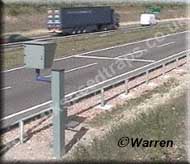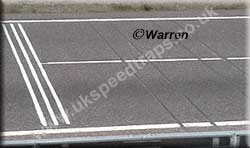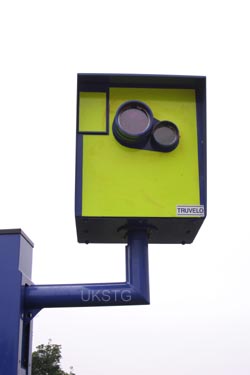TruVelo Forward Facing Fixed Installation
Post

Above: TruVelo
Forward Facing Camera
Facing the vehicle and taking a picture of the
Vehicle, VRN and the driver, by using a infrared flash gun as
not to distract the driver. The camera film is sensitive to infrared
the reflected light provides the film with the correct exposure.
The pictures shown are the TruVelo system using
Piezo Road Strips.
The single incriminating photograph will not be
sent unless the car owner asks for it - a Home Office ruling aimed
at avoiding embarrassing situations if a driver is photographed
with someone he would prefer not to be seen with.
How they Work The Piezo Road Strips are a
known distance apart, and the time between compression's is measured
to give the resulting speed of the vehicle. The system takes four
readings on a two axle vehicle and uses the average time for compression's
to calculate the resulting speed.

Above: Face Plate
showing Camera Position and Infrared Flash

Above: Piezo Sensor
road Strips
Forward facing Gatso are designed prevent offenders
saying it was not them driving.. and bribing friends to take the
blame.
That way they may avoid notching up more than 12
penalty points which, if amassed within three years, make a driver
liable to be banned for at least six months. Exceeding the speed
limit carries between three and six penalty points, although most
speed camera offences are dealt with by post and carry three.
As vehicles are currently photographed by the cameras
only from behind, it is difficult to be sure of a driver's identity.
Offenders nearing the 12-point limit are paying friends with better
driving records to say they were at the wheel.

Persuading or bribing someone else to take the
blame is the latest ruse in what police describe as the "dodgers'
charter" for speed cameras. Thousands have already escaped prosecution
for speeding or jumping red lights in this way.
Forward-facing FIPs are legal and in use in some
parts of the UK
The Association of Chief Police Officers have
asked road camera suppliers to develop a machine that can safely
and reliably photograph vehicles from the front.
They now have that camera, and it will become more
common.




